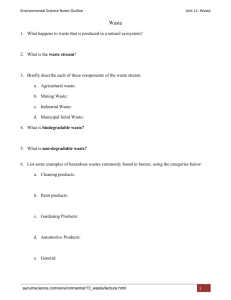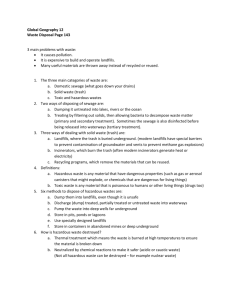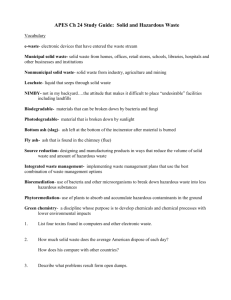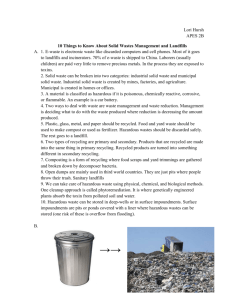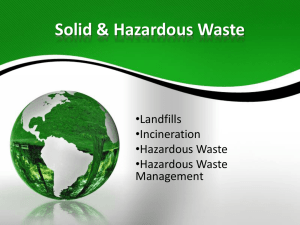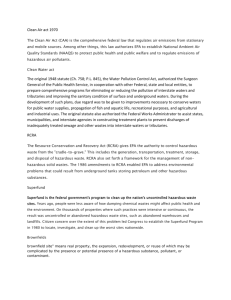Chapter 16 - Twinsburg Schools
advertisement
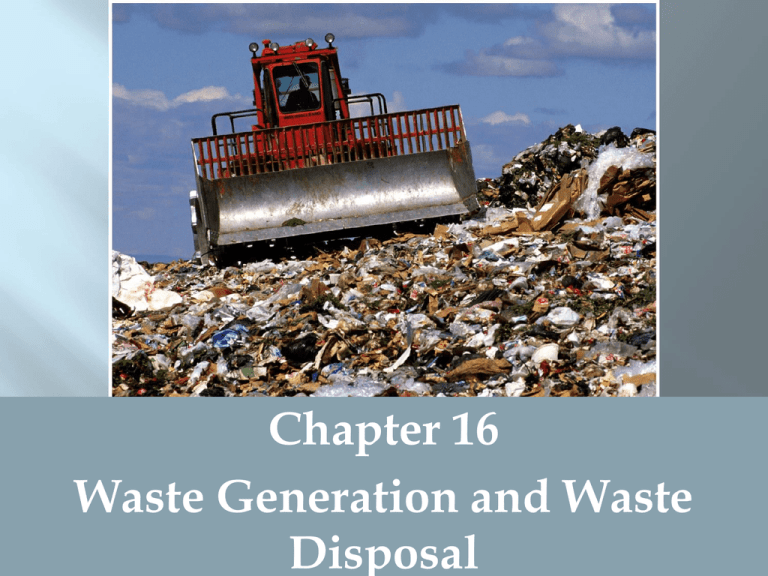
Chapter 16 Waste Generation and Waste Disposal Municipal Solid Waste Refuse collected by municipalities from households, small businesses, and institutions such as schools, prisons, municipal buildings and hospitals. Composition of Municipal Solid Waste 31% - paper 33%- organic materials (yard waste, food scraps, wood) 12%- plastic 18%- durable goods (appliances, tires) E-Waste Electronic waste (E-waste) televisions, computers, cell phones that contain toxic metals. Reduce, Reuse, Recycle Reduce- waste minimization or prevention Reuse- reusing something like a disposable cup more than once Recycle- materials are collected and converted into raw materials and then used to produce new objects Composting Compost- organic material that has decomposed under controlled conditions to produce an organic-rich material. Landfills Sanitary landfills- engineered ground facilities designed to hold MSW with as little contamination of the surrounding environment as possible. Leachate- the water that leaches through the solid waste and removes various chemical compounds with which it comes into contact. Incineration Incinerationthe process of burning waste materials to reduce its volume and mass and sometimes to generate electricity and heat. Hazardous Waste Hazardous waste- liquid, solid, gaseous, or sludge waste material that is harmful to humans or ecosystems. Collection sites for hazardous waste must be staffed with specially trained personnel. Hazardous waste must be treated before disposal. Laws Resource Conservation and Recovery Act (RCRA)- designed to reduce or eliminate hazardous waste. Also know as “cradle-to-grave” tracking. RCRA ensures that hazardous waste is tracked and properly disposed of. Laws Comprehensive Environmental Response, Compensation, and Liability Act (CERCLA)also know as “Superfund”. Puts a tax on the chemical and petroleum industries. This revenue is used to cleanup abandoned and nonoperating hazardous waste sites where a responsible party cannot be found. Requires the federal government to respond directly to the release of substance that may pose a threat to human health or the environment Brownfields Contaminated industrial or commercial sites that may require environmental cleanup before they can be redeveloped or expanded. Old factories, industrial areas and waterfronts, dry cleaners, gas stations, landfills, and rail yards are some examples. Integrated Waste Management A method that seeks to develop as many options as possible, to reduce environmental harm and cost. Reduction, recycling, composting, landfills, and incineration are some ways IWM is utilized.

